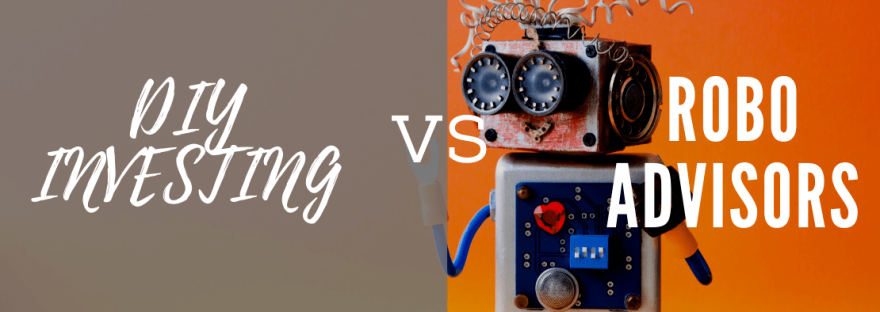Modern investors now face a dilemma when starting their investment journey – should I start investing myself, or should I go with a roboadvisor?
In this article, I hope to clarify the advantages and disadvantages of each approach and to help you choose which is better for you.
A lot that I share in this article is based on my experience and research (basically google search results) on roboadvisors in Singapore.
What Is A Roboadvisor?
Roboadvisor is a combination of two words – “robo” from “robot” and “advisor” from “financial advisor”. And no, it is not akin to letting a robot manage your investments for you.
What the name attempts to convey is a modern technology-based approach of providing financial advisor-ish services and wealth management for the masses.
In reality, the roboadvisors out there are quite different from each other.
The Robo Stuff
Some roboadvisors use technology as a platform, and humans make most of the investment decisions. These roboadvisors have a fancy app, some cool visualizations and interactive and responsive interfaces. But underneath the hood, all the risk profiling, portfolios are curated and designed by a team of humans.
Other roboadvisors have designed risk systems that continuously monitor the market and then re-allocates or rebalance your portfolios automatically. But of course, the primary decision making is still done by humans, and machines only handle the routine stuff.
I am not so sure whether humans trust robots to do the thinking for them yet.
The Advisor Stuff
As the name implies, roboadvisors are the modern evolution of the financial advisor. It acts as an advisor on your behalf to help you plan, save and invest to reach your financial goals.
Most of the roboadvisors collect your financial data to estimate your net worth. Then they will proceed to ask you a few questions to understand your risk, time frame, goals, and then recommend a risk-adjusted portfolio.
A lot of the roboadvisors also provide human, financial advisors to help craft a more personalized and holistic financial plan for you.
Some of the platforms also sell insurance and provide will writing services.
However, they are nowhere near replacing all the capabilities of real human financial advisor yet.
What Is DIY Investing?
DIY, or Do-It-Yourself, is probably the most common.
Just a few years ago, if you are not a wealthy person, you probably have to manage your investments yourself.
You would have opened a brokerage to buy stocks, bonds or mutual funds (unit trusts), or purchased some insurance products.
Nowadays, with the explosion of ETFs and inexpensive mutual funds, the average retail investor has more options to build a low-cost, globally diversified portfolio.
The DIY approach has become easier to implement – the Boglehead three-fund portfolio is an example of how easy it is to build a well-diversified portfolio.
So Which Approach Works Better For You?
We all have different needs and have varying experience and competencies in investing. So the right approach will depend on your ability, willingness and circumstances.
In the next section, I will use the analogy of cooking to help you decide whether DIY investing or roboadvisor is better for you.

#1 If You Don’t Know How To Start Investing
Financial gurus, bloggers and influencers often say this:
- The best way to learn to invest is to start doing it yourself, or
- the best way to learn investing is by losing money.
So, when you are new to investing, DIY should be the way. Right?
It depends on what you want actually.
If you have no idea how to cook, is it better to learn cooking or go out and eat at a restaurant or takeout?
Well, if your objective is to feed yourself with a delicious meal, you should go out and eat at a restaurant.
If your objective is to learn cooking because you think of starting a new hobby, then yes, go to Youtube and learn cooking from those Gordon Ramsey shows.
So, if your goal is to earn some returns or meet a financial commitment in the future, you should go with a roboadvisor. The robos get you started right away with no prior knowledge or experience in investing needed. It is frictionless.
For the DIY approach, you will need to research on decide on the brokerage, the assets, the allocation and the plan. There are a ton of prep work required before you even start buying your first stock or fund.
If your goal is to learn to invest, then a DIY approach is the better option.
But if you only want to get started with investing with no prior knowledge, I would recommend going with the roboadvisors.

#2 If You Don’t Have The Time
Imagine having to cook meals regularly for several years. Cooking a meal at home takes time. Going out to eat or eating takeout saves you time cooking because someone else did the cooking for you.
Before you cook a meal, you will have to source the ingredients and plan the recipe. And for Chinese meals, you will need to make sure the individual dishes complement each other and whether they go with rice. Imagine doing this every day for years.
By going out to eat at the restaurant, you save time by having someone prepare and cook the meal for you. All you need to do is focus on enjoying the meal and have more time to do other things.
Similar, investing consumes a lot of time. Typically, you will have to spend time upfront in researching, planning and designing your asset mix in your portfolio. Afterwhich, you will need more time to monitor and manage your investments over long periods.
Roboadvisors help you save all that time by preparing, implementing and managing the investment portfolio for you.

#3 If You Have Little Money To Start
It makes more economic sense to cook for a family than to cook just for yourself. You spend all the time and effort to cook and clean up after the mess only to feed one person. At least if you cook for five other persons, you are saving them time and impressing them with your culinary skills.
When you cook for five persons, you could whip up more dishes, prepare a five-course meal and introduce more variety. Whereas if you are cooking for one person, it seems a waste cooking more than a dish.
Likewise, a roboadvisor is a good option if you have little money to start investing. Usually, the roboadvisors have very low minimums investment sums and do not charge a commission. And with one investment, they will buy into several funds for you at once. It is perfect if you are starting with little capital.
Whereas, for a DIY approach, the brokerages usually charge a minimum commission for each trade.
For example, the lowest brokerage commission for the Singapore market is 0.08%, but the minimum commission fee is $10. So if you are buying $1,000 worth of stock, paying $10 is equivalent to a 1% commission fee. And if you are purchasing other shares, you need to pay commissions for each trade executed.

#4 If You Want More Control In Your Investments
If you are a parent with young kids, I am sure you could relate to me. When my first child was born, we were cooking all meals for her because we wanted to make sure she gets the best nutrition.
You made sure that all veggies and fruits are soaked and washed of all pesticides. We tried to use organic as much as we can and put less salt, no sugar and less oil in my child’s food. Cooking at home is the only option because we do not trust restaurants to adhere to our insane hygiene and nutrition standards.
Sure, you can go to the restaurant and specify you want less salt or less oil. But the chefs cannot deviate from the recipe too much, especially if you are eating in chain restaurants or fast-food restaurants (Roboadvisors are these types of restaurants). You can order a big mac with no cheese, but you cannot request a big mac with fish in a veggie bun served with spaghetti meatball sauce.
Also, you do not know how the chefs prepare the veggies and meat. Was it appropriately washed? Was overnight food used to make our meals? Was it fresh? There is no way to know unless we go to the kitchen to observe the kitchen staff.
Similarly, even though roboadvisors claim that they provide customized portfolios according to your goals and risks, there is only so much they can tweak. No roboadvisor is going to let you customize your portfolio with a Marijuana fund, with high ESG ratings that hold a short position on Argentinean bonds.
If you want a high degree of customization, the only way is to construct the portfolio yourself – the DIY approach.
With the DIY approach, you also get higher visibility in the portfolio construction process.

#5 You Want Control Over Your Costs
Eating out can be cheap, or it can be costly. It depends on where you go. Roboadvisors are like fast-food restaurants (or in the Singapore context, they are the hawker centres). The actively managed mutual funds are the typical restaurants. And hedge funds are the high-end fine dining restaurants.
The hawker centres offer cheap and tasty food which gives you value for every dollar spent. The only way to go cheaper is to cook the food yourself because now you don’t have to pay the cook. But the savings sometimes is significant if you consider the time and effort put into home cooking. It is no wonder Singaporeans love to go out and eat at their hawker centres.
The ways to control costs of home cooking are by batch preparing meals ahead of time, cook using seasonal ingredients which are on discount, making from scratch etc.
Similarly, DIY investing is the only option cheaper than Roboadvisors. You can control your costs better. For example, you could make lump sum investments to save on commission costs, construct a three-fund low maintenance index fund portfolio etc.

#6 If You Believe In Beating The Market
For Michelin starred restaurants, costs is not often the priority. The priority is often creating a culinary masterpiece or an experience of a lifetime irregardless of cost. They always believe they can do better and strive for perfection.
Whereas for a fast-food restaurant, their priority is serving a tasty yet affordable meal. Their philosophy is to keep costs under control and maximize utility. So, if you are a foodie, always on the look out for something better and not settling for the norm, you will seek out different restaurants to find the best experience. Or you could cook yourself and experiment on different kinds of flavours or techniques.
If you are not a foodie and just want to be fed, you can always go to hawker centres or fast food restaurants.
For roboadvisors, the underlying principle is keeping costs as low as possible with a passive (or pseudo passive strategy) investment strategy. They are not seeking to out perform the market.
Whereas, if you are an active investor, you seek to generate higher returns than the market. Very often, your priority will be how to generate more returns rather than keeping costs low.
So for investors who seek to beat the market, roboadvisors are not suited for them. DIY investing or investing in actively managed funds are the more suitable option for them.
Bonus Of Roboadvisors
One bonus point of roboadvisors is that they offer behavioural coaching support.
Just recently during the market crash in March, I got numerous articles and emails from the Roboadvisors which I have signed up with. In their emails, they kept reminding us of our investment objective and strategy and that we should be focused on the long run.
Despite all the doom and gloom from the media, the roboadvisors kept encouraging us to stick with the plan, and wait for the market to recover.
One one hand, the roboadvisors has an incentive to keep us invested with them so of course they will ask us to ‘focus on the long run’ or ‘stay invested’.
But on the other hand, those of us who signed up for roboadvisors should have bought in to the strategy of passive investing. Hence, reminding us to stick to the passive investing strategy is consistent and aligns with our interest too.
So, if you find yourself panicking or getting too worried about your investments, roboadvisors can sometimes play the role of the financial advisor and help you stick to your investment strategy.
In Summary
Whether Roboadvisor or DIY Investing is better depends on your needs and your situation.
Arguments in favour of selecting Roboadvisors:
- When you don’t know how to start investing – roboadvisors get you started quickly and easily
- When you don’t have the time or don’t want to spend time managing your investments
- When you have little money to start
- When you believe in passive investing strategies
- When you need behavioural coaching to help you stay focus when things get tough.
Arguments in favour of DIY investing
- When you want to learn investing
- When you want more customization in your investments
- When you want to control your costs better – even lower cost
- When you want to beat the market and generate much higher returns.
And if you are unsure between the two, why not do both? You can start putting most of your investments with a robo (maybe 80%) and use the remaining (20%) for DIY investing just to learn and have fun with the money.
These are just merely some of my thoughts and suggestions.


As always in life & investing, why not do both? Doesn’t always have to be binary, yes-or-no, all-or-nothing …. unlike being grilled by Shanmugam LOL!
After a few months or 1 year, compare the results. Good to keep a journal — NOT for the actual buy/sell or even the rationale for investment/divestment … BUT more of your FEELINGS especially when very scared, want to vomit / lau sai, and those times when very happy, feel like you’re master of the universe.
You’ll know whether you have the temperament & the stomach to be a stock picker!
LikeLike